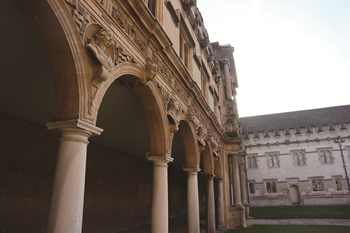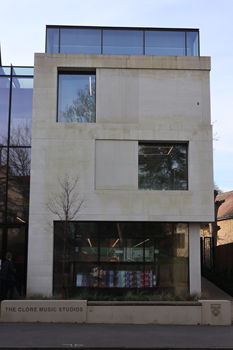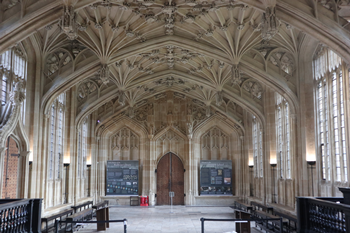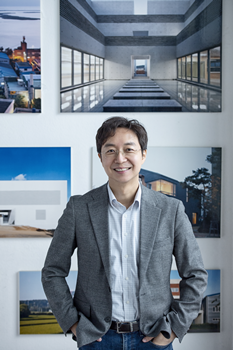
“We shape our buildings; thereafter they shape us.” The words of the late Winston Churchill speak of how buildings have an immense effect on us without many of us even realizing it. For example, a 2007 study by Jan Meyers-Levy and Rui (Juilet) Zhu found that ceiling heights can have a huge impact on the way people process their thoughts: the higher the ceiling, the more it allows creative thinking, while lower ceilings are more suitable for hands-on tasks that require concentration.
The final issue of this overseas series will explore how buildings affect the way we communicate by taking a look into the architecture in universities in Korea and the U.K. by meeting experts from each country. Before we begin, Ewha Voice would like to clarify that both Oxford and Cambridge have no central campus. Instead, their campuses consist of a number of colleges, individual institutions that make up the university. Each student and faculty member are a member of a college as well as their course department and the university itself.

University town: A fusion of town, university, and college where people of diverse majors interact
On Feb. 7, Ewha Voice sat down with Professor William Whyte of St. John’s College in Oxford. Whyte, who specializes in social and architectural history, shared his insights into how architecture is formed in Oxford and how those buildings eventually shaped the way people communicate.
He has been a fellow of St John’s College since 2002, and has been a member of the University of Oxford since he was an undergraduate student in 1994. “I have been here for my whole adult life,” he said chuckling. “I have an interest in the relationship between institutions and their buildings, why they build what they build, what they hope to achieve, and whether they manage to achieve their goals or not.”
Q: Oxford is a university with a huge campus but it’s also a town. How is Oxford architecturally different from other universities that have a more traditional form of campus?
Oxford is a strange fusion of town, university, and college. If you stand in the middle of Oxford and ask, “Where is the university?”, there is nothing you can point at because there is nothing that is “the university” in the way you might find elsewhere. But equally, you can point all around you and it will be “the university” in different forms.
This sort of happened by accident. Oxford was founded in the 11th century as a walled city. A town was built here because Oxford was at the meeting point of two distinct kingdoms within England. It was also the furthest point of which travel was possible up the river Thames from London, and also the first point where you could ford the river town. Hence, the name Oxford. So it was a commercial center that attracted monasteries and large churches. Then, these monasteries and large churches began to attract people who started teaching here. That’s how Oxford became a university town.


Q: What are the advantages of studying in a town-like university? What are the side effects?
The advantage for the town is that the university brings in a huge amount of money. The university is the town’s main employer and Oxford also has the largest concentration of high-tech startups. However, this also makes living outside of college very expensive for students. Another advantage is that you are part of a town and institution that is human scale. Because it is a town, more people from different faculties can mingle together rather than be stuck in one place. For the students, they are not just members of the university, but they will also be members of a college. All the colleges are multidisciplinary, so your friends you meet here will be studying different subjects.
At one o’clock after this interview, I will go to the senior common room (SCR) for lunch, and I will sit next to scientists and engineers. It goes the same for my students. You will be in a room while across the staircase there will be somebody doing a different subject. Upstairs, there will also be others doing completely different subjects and you will get to know each other because you are neighbors. For example, I am doing a project at the moment with two of the psychology fellows here. We happened to talk over lunch and decided to work together. You are forced to gather in these relatively small communities and it could be enormously enriching.
Q: So, the major purpose of a college is to allow people with different majors to interact together. How does the college building help achieve this goal?
The college tends to encourage talking. For example, in St. Catherine’s College, which is a 1960s building, you can see the attempt to create a modern college. The design you can see there are relatively small bedrooms and large social places precisely to encourage interaction. The same is true with some of our multi-buildings here in St. John’s College, which are designed to force people together.
The private spaces are arranged in such ways that maximize encounters. Instead of having long corridors, there are staircases where two people are on the same level. Through this, you get to know the person across the landing from you and also people above you. The staircase usually has a kitchen and this becomes a little community within the bigger community.
How to transform a space into a place
Q: According to Korean Ministry of SMEs and Startups, there are over 77,000 cafes in the country, almost half of them centered in the metropolitan area. The lack of public space in the street where people can exchange conversation with strangers is pushing people to go to cafes, which is practically the only choice they have. How do you think a space can be turned into a place?
To turn a space into a place, there are two critical things that work in most of Oxford. One is having additional space, which does not mean huge spaces, but spaces between things that are not designated as commercial or functional. The second thing is how you make it meaningful and how you make it attractive for people to come. Actually, it turns out that you do not have to do much. A bench and a tree will completely turn an interstitial space into a place.
There is a lovely example of it in Mansfield Road. A new building called Music Center for New College has just been built. The building is a private space just for the members of the college who want to practice music. But outside the building, they built a retaining wall that is also a bench. They also put a window so people sitting on the bench can look into the practice rooms. This shows that an anonymous gap with a patch of ground has become a place where people go, sit on the bench, talk, and watch rehearsals. I think it is the most useful thing the college could have done.
Q: What is one building that you think best represents the key idea of debating and talking in Oxford?
I would pick the Divinity School. There are two pulpits in the Divinity School, and those were for debates. When the Divinity School was first built in the 15th century, the way in which you graduated was not through a written exam, it was through a debate. You made a speech, somebody contradicted you, and you responded. In the 17th century, the parliament moved in, and the British Parliament or the English Parliament was actually in the Divinity School. Therefore, the Divinity School is a place that is designed for debating and disputes. It goes to the heart of what Oxford is about.

Q: Which building in Oxford are you most interested in if you had to pick one?
The building that I am most interested in at the moment has not even been built yet. We have only just chosen the architect for it. The university received a major donation of 150 million dollars to build a new center for the humanities. At the heart of this building, there will be a space that is designed to bring humanities departments such as English, history, modern languages, linguistics, philosophy, and music together.
There are two good reasons why this building matters. One is that it is an investment in the humanities and nowadays humanities can be a little vulnerable. It proves that there are people committed to humanities and see the value of it. The second reason is that it will bring those different humanities majors in a single place. It doesn’t just mean that they are more conveniently situated. It means that they can talk to each other, and interesting things happen when diverse majors talk to each other.
Buildings, culture, weather, and how they influence each other

In Seoul, home to more than 9.7 million people and 49 universities, a university town is an unfamiliar concept due to realistic obstacles such as lack of space to begin with. Yoo Hyun-joon, the representative director of Hyunjoon Architects and an architectural design professor at Hongik University, therefore suggests other feasible ways schools in Korea can change for the better.
To hear more about his ideal of a school, Ewha Voice interviewed Yoo via Skype after coming back from the two-week trip to the U.K.
Yoo started off by explaining that in Korea, there is a tendency to work in a group that was influenced by the country being located at the far east of Asia, where it is rainy. Living in a region suitable for rice farming, Korean society was almost forced to work together as a group to successfully cultivate rice. On the other hand, the climate in Europe was ideal for wheat farming, which can be harvested individually at any time.
“Rice farming strengthened the notion of a group mindset among Koreans,” Yoo said. “As their reputation among people around them played an important role, people became more uniform and were discouraged from doing anything that would make them stand out. For example, panic-buying rarely happened in Korea during the coronavirus outbreak unlike many western countries. Reputation matters a lot here and this may have produced good outcomes such as Koreans being able to cooperate during a crisis. However, it also pushes people to contain their inner thoughts and not speak up.”
Containing inner thoughts explains the difference between Asian and European education and how they approach communication. A study by Kim Hee-jung, Ewha alumnae and professor in the Department of Psychological & Brain Sciences at the University of California Santa Barbara, has proven that the relationship between talking and thinking is a lot closer for Europeans and Americans than for East Asians. Her study reveals that talking to others impaired the performance of Asian Americans because they are more familiar to internal speech.
According to Yoo, starting from elementary school, what the school buildings in Korea do is reinforce this idea of having to stick to a group and discourage students from speaking up.
“There is nothing different between a Korean school and a prison in terms of the shape of buildings,” Yoo said. “Classrooms in Korea are optimized for surveillance because a teacher easily monitors 30 students by standing in the front. Likewise, the principal will be able to monitor the whole classroom unilaterally by standing in the hallway and looking through the window.”
Yoo points out that this is how diversity of thought, the most essential factor for discussion, is lost. In order to put a stop to this homogenization and absence of dispute, he argues the need for a change in architecture. He believes that the deformation of school buildings will stop students from assimilating and will promote their diversity.
Yoo Hyun-joon’s ideal of a school: The Smurfs’ Village
“A village similar to the Smurfs’ village is what I propose as an alternative way of building a new school. In the ‘Smurf Village School’ that I envision, the school buildings are low-rise and are separated into small units. In front of the buildings, there are yards with different shapes.”
Yoo insists on making outdoor routes for students at school so that they can face each other outdoors instead of staring at the board indoors. He believes the synergy that occurs when people make eye contact is immense.
“Instead of high-rise buildings, buildings with lower stories should be built for students to easily access the lawn or square during their free time,” Yoo said. “Squares are an efficient space for discussion as they are places where students can stay and talk at no cost. When students are in need of a friendly conversation, a square can become a much better alternative to a coffee shop, which takes time to search for and costs money to occupy.”
For example, students of Korea University spend their time together at Central Square, a large space in their campus available for them to walk around or sit, rest, and eat. Yoo commented that unfortunately squares can only be made on flat land and cannot be made on mountains because of their inclination and tendency to slope in a direction. He considers Konkuk University a school that has potential in making a square on campus as it is one of the few universities in Korea that is located on flat ground.

As for other universities that are located on mountains such as Ewha, Yoo suggests schools to break down empty classrooms for outdoor spaces. Instead of making unused rooms into unnecessary special activity rooms, the space would become more valuable when torn down and made into a terrace. It could become an open space where a few benches are installed for students to sit down and converse.
Opening the rooftop of buildings and providing spaces for students is another option that Yoo recommends. At Dongguk University, for instance, there is Haneul Maru which is a generic term for the gardens that are on the rooftop of school buildings. The Haneul Maru on Central Library is especially renowned for its scenery of Namsan which students can enjoy while sitting and talking on wooden chairs and benches.
The closing remark Yoo made on Sebasi, a program similar to TED Talks, sends an important message for the future generation in South Korea.
“Schools are public buildings made from the taxes we pay. That makes every one of us the building’s owner. As an owner, take interest and create a change. People shape their cities and cities shape the people, which means the spaces we make continually shape our lives in a cyclical manner. The school buildings we construct determine the future of this society.”
Looking back,
Ryu Seo-yeon: This overseas coverage revolved around the concept of debating and communicating and their importance in our society. The series, which was divided into three editions, explored the tutorial system, student debating societies, and finally how architecture plays a huge role in the way people communicate.
It was my first overseas investigation and travelling U.K. for two weeks as a journalist was an invaluable experience that allowed me to grow as a reporter. As a third culture kid, it was also interesting to include and learn about the role of cultures in communication and gain new perspectives. Lastly, as much as this series provided new information to our readers, I hope it also successfully managed to make the readers ask more questions and encouraged them to take a more active role in their society. For more information about this series, you can also find me on brunch.co.kr/@seoryu15.
Jeong You-hyun: The two-week trip to the U.K. investigating the debating culture at Oxford and Cambridge was full of rare and special opportunities. We were welcomed by tutors and supervisors to sit in on their tutorials/supervisions. We were also able to attend members-only formal debates at Oxford Union and Cambridge Union. Thanks to Han Sungwon who invited us to the Lady Margaret Hall’s chapel and formal dinner, we had the chance to have a taste of life at Oxford. These were valuable experiences that could not have happened were it not for this overseas coverage.
Although everyone we met during our overseas investigation has been extremely helpful, we would like to say special thanks to Jang Jae-won from the Ewha Media Center; Han Sungwon from Department of Pharmacology, University of Oxford; former Director of Press and Public Relations at the Oxford Union, Louisa Broeg; Cambridge Union’s Head of Press, Seo Jung-min; and everyone else who contributed to this overseas coverage for all the help and valuable insights they provided.

